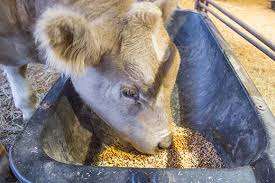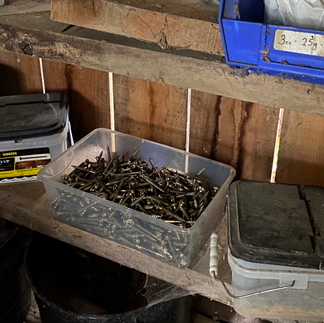Prepping the Homestead - A Guy's Point of View
- Lions, Eagles, and Bears

- Sep 29, 2024
- 7 min read
Updated: Oct 8, 2024

The Weather Men and Women provide weather information that we need.
However. Don’t believe everything they say. It’s usually Hype.
For example:
· The meteorologist stated the coldest it has ever been in Ohio is -28 degrees F. Except I lived through -49 in 1963 and WHCB Canton radio reported -52 at Robertsville, Ohio weather station
· The meteorologist claimed that the warmest it has been in June is 96 degrees. I worked construction in my youth and WHBC radio reported 104 degrees and the local thermometer was 102 degrees in the shade.
· Again, the local meteorologist stated the most snow we had is under 6” per day. Well how did the Blizzard of 1978 pile over 10 feet of snow on I 77 by the Pro Football Hall of Fame? How many days of 6” snow would that be?
· Another meteorologist said this is the worst drought ever. But that depends where you are in the region. Micro-climates make a HUGE difference in summer rainfall in Ohio. We have had serious droughts in 1960 and 1988, too.
Instead of believing a meteorologist who wants to sensationalize everything for ratings, check with older farmers who lived through those weather situations. Their perspective is probably more helpful to you, as a homesteader.
A few trends that have held true in my experience of over 60 years as a farmer/homesteader:
· After a hot and long drought in summer (and sometimes 2 summers in a row), the following summer is rainy and overcast. This makes it hard to harvest hay and grains, grow gardens.
· After several mild winters, button down the hatches, son… Double down on your firewood supply to keep warm and have extra feed for your livestock. It’s going to be a bad one.
So why am I concerned? And why am I prepping?
Depending which television station you watch, you probably think everything is absolutely FINE or it’s all going to crap.
Sometimes, you need to listen ‘around’ the hype and recognize what your eyes and experience are telling you.
This is what my 74 years of experience are telling me:
Our economic situation stinks: high prices, poor quality products, and supply chain problems are soaring.
Also, every week some bad guy/country is hacking various computer systems, causing temporary shutdowns of industries and markets.
What happens when they hack all the systems and shut down a huge part of our industries? It's been obvious hackers are probing for weaknesses.
Then, there is the war in Russia/Ukraine and the Middle East with Israel against multiple terrorist groups. Plus Russia, North Korea, and China are rattling their swords.
I’m concerned.
And, I’m prepping.
Even if you have never ‘prepped’ before, read over the rest of the blog to see if there is an area you need to address.
I’m going to make a checklist of various homesteading items you should address NOW!!!
1. If you have livestock, put up as much hay as you can store and/or afford.

Round bales don't require a building or shed for storage. You will need the equipment to take them to the animals OR stage them so the animals have access to only one or two at a time.
2. Install electric fence around the homestead corn field. Each acre of harvested corn stalks, in a normal year, provides 60 cow days of feed. (If you have 1 cow, this means it will provide feed for 60 days, for 2 cows it means 30 days, 4 cows – 15 days and so forth.) Of course, with the drought you will probably get a little less.

Cows will graze the stalks, leaves, cobs, and missed ears. Basically, free food.
3. Cut enough firewood for 2 years, even if you only bring the second year’s supply into the homestead. You can more easily process it later if you need it. Remember – firewood decays after 3 years, even if stored inside/under cover.

Everyone should have at least a 1/2 cord of dry firewood stored for
emergency off-grid cooking and heating.
4. Buy additional livestock grain and store it in rodent proof containers. Look at alternative feed sources. We saw fields planted with turnips this week. Acres and acres of second crop turnips. Remember supply problems affect pet feed, too, so stock up on your favorite.
Storing feed in the right container is important.
If your barrel was used before make sure it had only food grade stuff in it.
5. Buy spare parts you usually replace and get those new items you were planning to purchase next year.
Spare parts for your automobile, chainsaw, meat processing, wood burners are essential. Here are fuel and oil filters, chain saws and spare chains, various weights of oil and fuel mixes.
6. Can, freeze, and dry extra fruit, vegetables, and meat.
7. If possible, can versus freezing. If the power goes out your food will still be safe. How much food can your family eat in 3 days if the freezer dies?

Canning is always preferred for long term storage.
Keep your filled jars in a cool, dark place.
8. Plant a fall or winter garden. Build cold frames to extend the growing season and to kick start your garden next spring. There are lots of instructions online that show you how to build cold frame from scrap lumber and old windows.
9. Raise a flock of meat chickens this fall.
10. Please don’t depend on hunting to support your family in a SHTF scenario. Every neighbor will be doing the same thing. Remember, there are actually less than 15 deer per square mile. That leaves 4 deer per family if there are 4 families hunting. But most important, learn how to process a complete deer. This includes butchering, storing through canning with a pressure canner, drying for jerky, using the bones for bone-broth and canning it, organ meat for eating or animal food.

Even the younger folks can put food on the table.
Be realistic about your hunting and meat processing skills.
11. Store fuel. Stable 360 is the only tested fuel additive for fuel that will last a year. Any gasoline containing ethanol breaks down in less than 90 days – usually it starts to deteriorate at 60 days. Diesel fuel breaks down in less than a year, too. Canned gas has a life of 2 years in the can but the cans aren’t date stamped. You need to test the fuel before putting it in your equipment.

12. ‘OK, I don’t use firewood to cook with or heat my home? Why do I need to have some?’ What if the power goes out? How long will your propane last if you are cooking with it 2 or 3 times a day? I recommend everyone have at least a ½ cord of split firewood to cook with. You can use it to heat your living space, too, in a real grid-down emergency. Fill your propane tanks, too.
13. Stock up on hardware items – screws, nails, bolts, tools, tape, rope, wire, string, adhesives. I’m using battery operated power tools now. I can charge the batteries with my solar generator even if the grid is down. I stick with the same manufacturer so the batteries are interchangeable. Also, think about heavy dark plastic to occlude windows, extra wood for projects and repairs, tarps of various sizes, duct tape.
Nails, screws, bolts, etc.
I also have cutting knives, spare tires for equipment, and much more.
I buy on sale and scavange what I can before I throw stuff out.
14. Develop a communications system for family and friends. Ham Radio is the gold standard of off-grid communications, but it requires a license and training to use the radios. Believe me, they aren’t walkie-talkies. Each handheld model is a micro-computer with complicated programming to use effectively.
Instead, think about getting a GMRS license from the FCC – they have a range of about 3 miles. One license covers everyone in your family – no tests, just a fee every 10 years to keep it active. Some cities and communities have GMRS repeaters to send the message further. Your neighbors should have them, too. Have a select channel and time you all use for communication in the event of a crisis. GMRS radios come in both handheld (walkie-talkie) and a base station.
Ham radio is a great hobby but the radios can be complicated to use and expensive.
There are some handhelds available for $25 - 35, though their reliability isn't great.
Licensure is required and Ham operators are very obsessive about weeding out
people using the airwaves without licensure.
On the far right are 2 GMRS radios. The base can plug into a car cigarette lighter or a solar generator.
The handheld was about $60 for the pair. We use them on our property with good results.
The license for GMRS is also available from the FCC but doesn't require testing. Only a small fee.
Another thing to do is set up an emergency plan with your trusted neighbors and family. For example, decide that if SHTF you will all meet at 11 am on Tuesdays in Bill’s back yard at his picnic shelter. Pick a central location for your group. This also keeps your group local. At that meeting you can determine your next meeting time and location. Personally, I’d mix it up a little, changing day/time/place for each get together. This is a great way to exchange information, discover needs others may have, and plan security. Later on it can become your barter/sell time. Of course, each family sends only one or two representatives – someone should stay home for security.
You must have others in your circle – how many more people would have died during the Blizzard of 1978 without their neighbors helping and looking after them?

Winter 1977-78 was wild.
On the other hand, NOT EVERYONE should be in your circle. Be wise in your choices and start small. If someone is a show-off/big mouth or untrustworthy NOW, how much worse will it be when life is on the edge?
15. Remember to stock your medical kit. You might not be able to get to emergency medical care and will need to do the best you can. Polly wrote an earlier blog about putting your medical supplies together so I’ll just hit the highlights. Determine what medical supplies and needs are unique to your family. Medical supplies generally have a long shelf life if stored properly. Usually it is the outer wrapping which becomes compromised. Keep supplies dry and out of light. Avoid excess heat, too. Dollar Tree has a lot of inexpensive items to carry you through the winter months. Check out Polly’s blog for more details.
16. Brain storm with your family and close friends to see what you might need to add.
Why am I proposing this? As one prepper said, “We aren’t prepping. We are building an ark.”
Stay aware.
Bob





























Comments